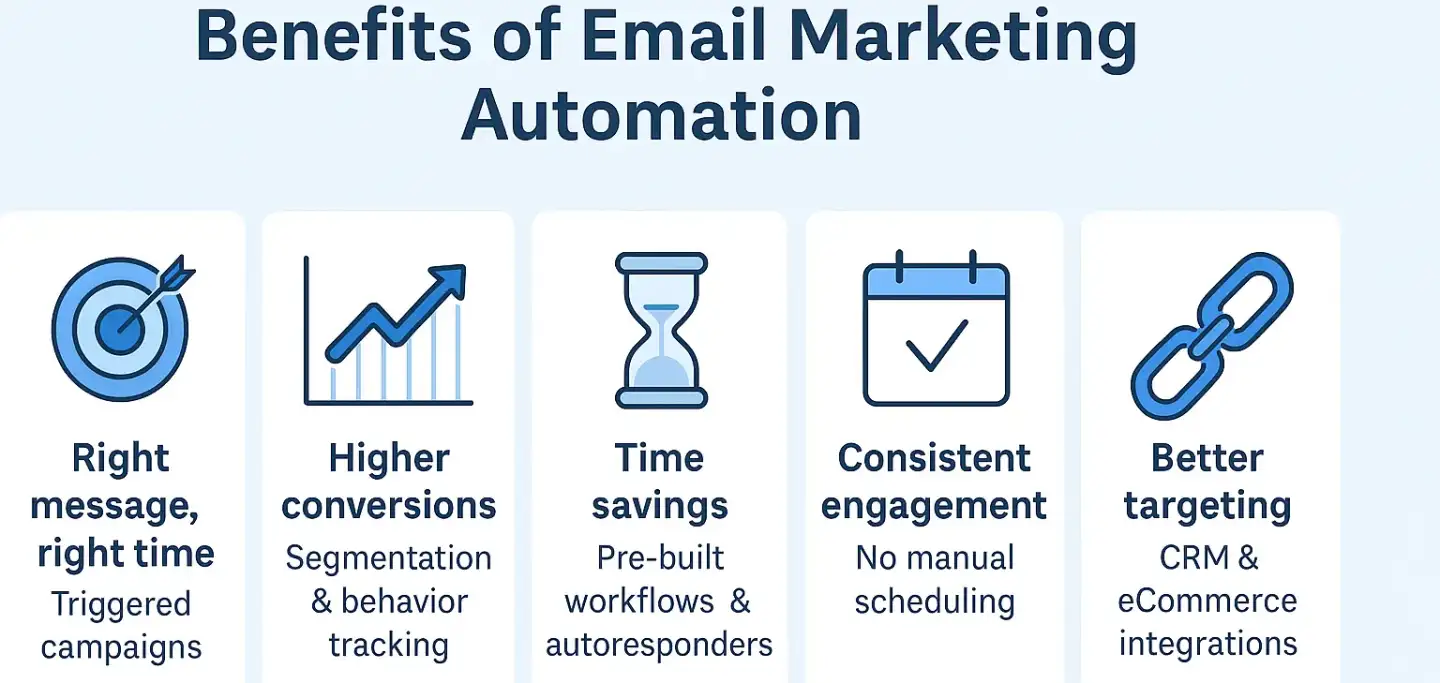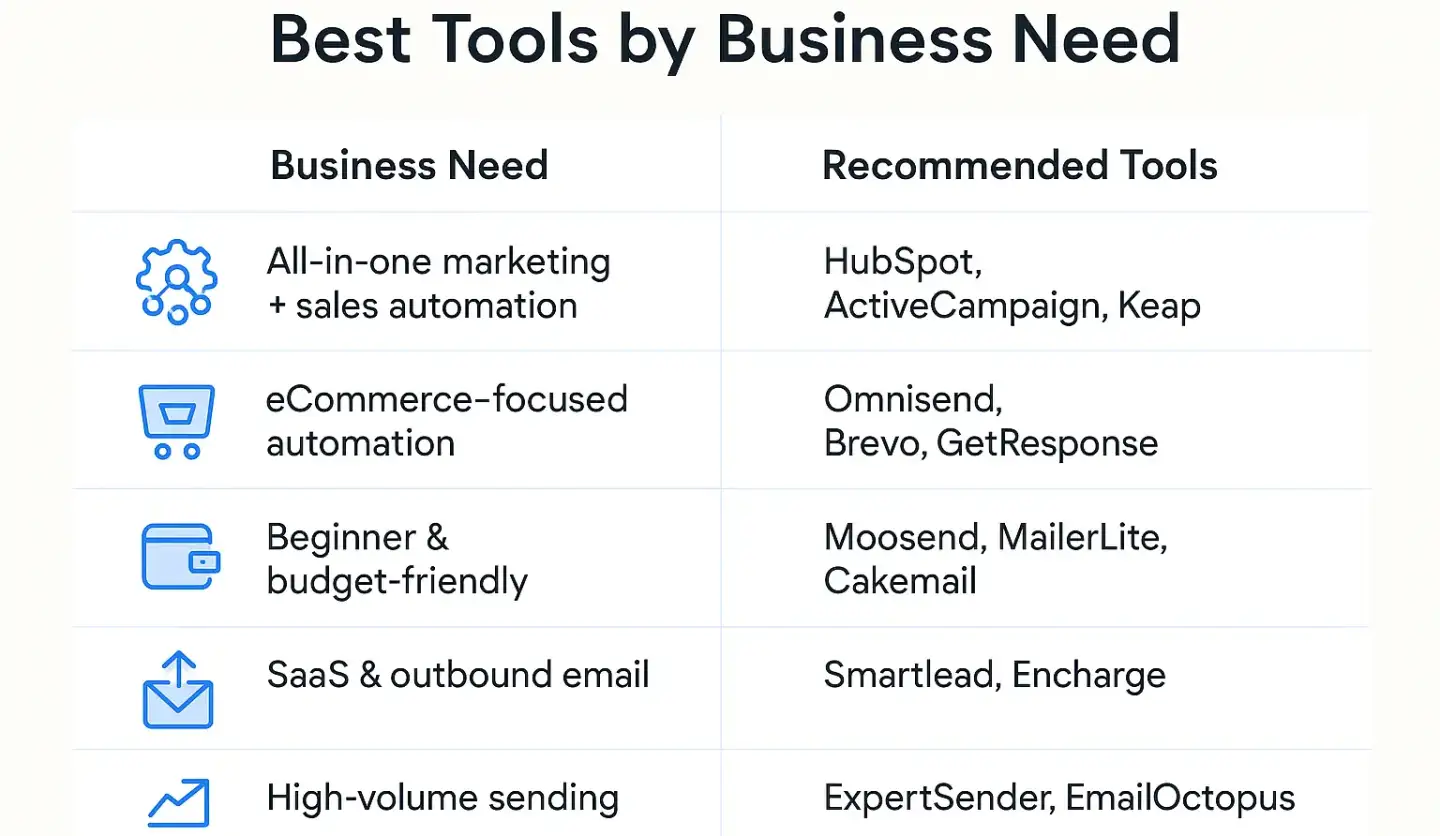We test and review software products using an independent, multipoint methodology. If you purchase something through our links, we may earn a commission. Read about our editorial process.
Email marketing remains one of the highest ROI channels for businesses—delivering an average of $36 for every $1 spent. But in today’s competitive landscape, sending static email blasts isn’t enough. To stay ahead, brands need automation—personalized, timely, and behavior-driven email campaigns that nurture leads, drive sales, and build long-term customer relationships.
This guide explores the best email marketing automation tools in 2025, featuring HubSpot, Moosend, Omnisend, Encharge, ActiveCampaign, GetResponse, Keap, Brevo, SendX, SendPulse, Campaigner, MailerLite, Cakemail, EmailOctopus, AWeber, iContact, ExpertSender, Constant Contact, Mailmodo, Zoho Marketing Automation, and Smartlead. These platforms are ranked based on their ability to streamline workflows, personalize content, and integrate with your overall marketing strategy.
Automation transforms your email marketing from generic to personalized, helping you:

Target the right audience at the right time with triggered campaigns
Improve conversion rates through segmentation and behavioral tracking
Save time with pre-built workflows and autoresponders
Maintain consistent engagement without manual scheduling
Integrate data from CRM, eCommerce, and analytics platforms for more precise targeting
In 2025, successful campaigns are driven by real-time insights and personalization at scale, making automation not just a convenience—but a necessity.
We use an internal 6-step methodology to select the best tools:
Feature depth – We prioritize platforms offering advanced automation triggers, conditional logic, lead scoring, and AI personalization
Ease of use – Interfaces must be intuitive enough for beginners but powerful enough for advanced marketers
Integration ecosystem – Tools should connect seamlessly with CRMs, eCommerce systems, and analytics platforms
Scalability – Solutions should cater to small businesses and be able to handle enterprise-level volume without performance drops
Deliverability – We test inbox placement rates and compliance with major ISP requirements
ROI impact – We analyze how each platform’s automation improves engagement, reduces churn, and drives revenue
This approach ensures our recommendations aren’t just feature-rich but also practical for real-world marketing needs.
HubSpot’s Marketing Hub is a full-funnel marketing automation solution, combining CRM data with sophisticated email workflows. You can create highly personalized sequences, A/B test every element, and track conversions in real-time. The visual workflow builder is intuitive yet powerful, supporting branching logic and multi-channel triggers.
Best for: Businesses wanting an all-in-one CRM + marketing automation ecosystem
Moosend offers affordability without sacrificing advanced automation. Its drag-and-drop workflow builder lets you set up triggers based on customer behavior, purchase history, and engagement scores. Pre-made automation templates make it ideal for SMBs.
Best for: Small to mid-sized businesses seeking budget-friendly automation
Omnisend specializes in eCommerce automation with deep integrations into Shopify, WooCommerce, and BigCommerce. You can build workflows for abandoned carts, post-purchase follow-ups, and personalized product recommendations.
Best for: Online stores wanting revenue-focused automation
Encharge is built for SaaS and B2B companies, offering behavioral email sequences, product onboarding flows, and trial-to-paid conversion campaigns. It integrates natively with tools like Segment and Intercom.
Best for: SaaS companies optimizing customer journeys
ActiveCampaign is one of the most advanced automation platforms, with powerful segmentation, conditional content, and multi-channel follow-ups. The platform excels at combining email with SMS and site messaging.
Best for: Businesses needing deep personalization and multi-channel campaigns
GetResponse provides a mix of ease-of-use and advanced features like webinar funnels, sales automation, and AI subject line suggestions. It’s ideal for marketers running lead generation campaigns.
Best for: Marketers blending webinars, landing pages, and email into one funnel
Keap (formerly Infusionsoft) is focused on automation for sales-driven businesses. It combines CRM, invoicing, and marketing automation in a single platform.
Best for: Service-based businesses managing both marketing and sales workflows
Brevo offers marketing automation at a competitive price, with a visual workflow builder, SMS marketing, and transactional email support.
Best for: Businesses looking for cost-effective automation with multi-channel capabilities
SendX prioritizes simplicity with unlimited email sends, an easy workflow creator, and automation triggers like form submissions and link clicks.
Best for: Startups wanting unlimited sends without overcomplicated features
SendPulse’s Automation 360 combines email, SMS, and chatbots in a single workflow. It’s particularly useful for omnichannel engagement.
Best for: Businesses wanting email + chatbot + SMS in one automation flow
Campaigner is a veteran email platform with advanced automation, deliverability optimization, and deep segmentation tools.
Best for: Businesses with large subscriber lists that need precision targeting
MailerLite balances ease-of-use and automation flexibility. Its visual builder and clean UI make it beginner-friendly while still offering segmentation and triggers.
Best for: Beginners wanting a quick learning curve
Cakemail focuses on simplicity for small businesses. It’s great for setting up basic automated sequences without a steep learning curve.
Best for: Local businesses or first-time email marketers
EmailOctopus is known for its low-cost, high-volume sending through Amazon SES. It offers basic automation for budget-conscious marketers.
Best for: Cost-sensitive senders with large lists
AWeber has been in the email space for decades, with reliable automation, tagging, and autoresponder capabilities.
Best for: Entrepreneurs and small businesses needing proven reliability
iContact offers simple automation, drag-and-drop editing, and detailed reporting, making it ideal for SMBs.
Best for: SMBs needing straightforward automation
ExpertSender is designed for high-volume senders, offering complex automation flows and advanced data segmentation.
Best for: Enterprises and high-volume eCommerce stores
Constant Contact offers easy automation, eCommerce integration, and strong customer support.
Best for: Nonprofits and small businesses wanting a supportive platform
Mailmodo stands out for interactive AMP emails, allowing users to complete actions directly inside the email.
Best for: Marketers using interactive forms and surveys in emails
Zoho’s platform integrates with its entire business suite, offering lead scoring, segmentation, and CRM-driven workflows.
Best for: Businesses already using Zoho ecosystem
Smartlead is aimed at cold email outreach automation with personalization and inbox rotation for deliverability.
Best for: Sales teams running outbound campaigns at scale
Email marketing automation in 2025 is about personalization, timing, and integration. The best tool for you depends on your business model:

Choose HubSpot, ActiveCampaign, or Keap for all-in-one marketing and sales automation
Select Omnisend, Brevo, or GetResponse for eCommerce
Pick Moosend, MailerLite, or Cakemail if you’re a beginner or budget-conscious
Use Smartlead or Encharge for outbound and SaaS-focused workflows
Investing in the right platform will not only save you time but will also turn your email campaigns into a consistent revenue channel.
There are several aspects of marketing processes that are particularly amenable to automation. One of them is data analytics. Modern systems can automatically collect, process, and analyze large amounts of information, giving companies the ability to make strategic decisions based on objective data.
In addition, automation of advertising campaign management on digital platforms is a key aspect. Automation tools allow you to optimize advertising budgets, identify target audiences, and maximize the effectiveness of advertising efforts.
All these aspects are chosen for automation because they help to increase efficiency, reduce human errors, speed up processes, and improve the results of companies' marketing strategies.
In modern marketing, automation has become an integral part of optimizing various processes. Some of the aspects that are most amenable to automation include:
Email marketing: Email sending automation is able to improve the personalization of messages using customer data. This includes audience segmentation, creating email templates, and sending emails automatically based on certain conditions.
Social media: Automation tools allow you to schedule posts, analyze audience reactions, track brand mentions, and respond to them automatically.
Analytics and reporting: Automated data collection systems allow you to analyze campaign results faster, generate reports, and predict marketing strategies based on this data.
CRM (Customer Relationship Management): Automation in CRM helps you manage your customer base, interact with them, create customized offers, and maintain customer relationships.
Other key factors include the appropriate integration of automation systems with the company's existing processes and technology stack. This is important because a harmonious combination of different systems allows you to maximize their capabilities and potential.
Communication and cooperation between different departments of the company is also crucial. Interaction between marketing, sales, IT, and executive management helps ensure the successful implementation and use of automation systems.
Understanding and support from the top level of the company's management is also a critical factor. Leadership that actively supports marketing automation initiatives creates a favorable atmosphere for the development and implementation of new ideas.
Finally, constant evaluation and analysis of results, as well as a willingness to adjust strategies, are essential for the successful implementation of automated marketing systems. Continuous improvement and adapting to changes in an effective way help to ensure the success of using such systems in a company.
In implementing marketing automation in large companies, opportunities include a significant amount of data for analysis and personalization, the ability to integrate a variety of systems for optimal performance, and the ability to expand with access to resources.
At the same time, large companies may face obstacles, such as the complexity of implementing systems due to their size, the need for large amounts of time and money for integration, and the need for a large number of processes to interact with complex structures.
In small companies, automation can be less difficult to implement due to the smaller amount of data and ease of integration. They can also adapt to changes more quickly and implement new tools without high costs.
However, small companies can be hampered by a limited budget for implementing high-tech systems and a lack of resources to effectively use automation.
Marketing automation and CRM (Customer Relationship Management) are two different but interrelated aspects of business and marketing.
Marketing automation usually covers a broader range of tools and processes aimed at automating marketing tasks. This includes email automation, social media, analytics and reporting, content management, and more. The main goal of marketing automation is to improve the efficiency of marketing processes and provide a more personalized approach to customers.
In contrast, CRM is a customer relationship management system that focuses on collecting, managing, and analyzing customer data. CRM helps to manage the customer base, interact with them, identify their needs and wishes to improve the relationship.
The difference, therefore, is that marketing automation is a broader concept that includes a variety of tools and processes to support marketing activities, while CRM is aimed at managing customer relationships and optimizing communication with customers. However, both aspects can be used together to create a more effective and personalized marketing strategy.